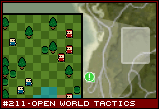|
Mechanic #211 - Open World Tactics |
 | Posted: Apr 21, 2016
Select the size and shape of your battlefield from anywhere on a large open map. |
This idea is sort of based on Bushido Blade, which was a somewhat open world fighting game. There was a giant castle you could go around and fight in - if you wanted. I won the game several times in the first room never knowing you could leave it. The benefits of an open world, other than the exploration aspect, is that it gives variety to the encounters organically. You might be chasing a bad and catch him in a tunnel, or on the docks, or on the freeway, leading to different shoot out experiences every time. Even better, in some open world games, you can plan ahead, such that you can decide to block the tunnel, ensuring that you'll fight your enemy in an enclosed space with no reinforcements. That sort of control over your experience is something that tactics games never have... until now.
![[tactics1.png]](set11/img/entry211-tactics1.png)
Fig 211.1 - Your world, your choice.
Note: Picture of island borrowed from Just Cause's map screen.
The basic premise is that the game world is fully realized and you just select a part of it to play in. Think of it as a giant miniature table, but you get to arbitrarily draw boundaries as you like. Maybe you want a small game around the castle, or maybe a battle in a canyon, or maybe you just want to use the entire table at one time for a truly epic tactical experience.
This world has all sorts of terrain features, buildings, fortresses, and road. Draw a rectangle anywhere on the map and that becomes your battlefield. Whatever enemies inhabit that section of the map are your enemies. You can place your units along any boundary edge. And then you fight. Want to conquer a whole town? Fine. Want to conquer just one building? Fine. Want to have a battle the encompasses a long skinny ravine? Fine. Maybe an enemy compound has a secret way in just outside the base? Make the boundaries a little larger than usual and infiltrate the base through it.
The size of the battlefield will control how many units you can bring it, and what kind (vehicles require larger battlefields).
![[tactics2.png]](set11/img/entry211-tactics2.png)
Fig 211.2 - Contiguous zones.
To add a new wrinkle to the idea, there are contiguous zones - sections of the map that must be entirely inside the boundaries of a battlefield. You can't bisect a building, for example. It's all or nothing.
![[tactics3.png]](set11/img/entry211-tactics3.png)
Fig 211.3 - River zones.
There are different kinds of contiguous zones. The first are grey zones, which represent neutral features that must be wholly represented inside a battlefield. For instance, a river might be made up of several long rectangular zones, each one containing a bridge. This ensures that whatever battlefield includes a river will necessarily include a way to cross it.
The next contiguous zone are white zones, which are basically walls that no battlefield may include. This can be used to massage the boundaries of complicated terrain to ensure that whatever battlefield is selected is something that can be worked with. For instance, a mountain range could have a white zone preventing players from creating a battlefield on two sides of a mountain simultaneously.
![[tactics4.png]](set11/img/entry211-tactics4.png)
Fig 211.4 - The Red Zone is for loading and unloading only.
Red zones represent enemy strongholds that can be taken over. Each one will have different requirements, but in general, killing all the enemies inside it will conquer it. Larger and more complicated strongholds may require turning the power off, freeing the prisoners, or conquering other strongholds first. Once a red zone is conquered, it becomes a green zone.
Green zones are player owned properties that they either earn or take over in some manner. They give an immediate benefit to players in that they can be, when included in a battlefield, used as a deployment zone for your units (rather than coming in from an outside border). This can give you a quick way to the center of a battlefield and can also come with other benefits. For example, if you start a battlefield from a tank depot, you will have tanks at your disposal. Creating battlefields with the right combination of green zones and red zones can greatly affect your mission at hand.
![[tactics5.png]](set11/img/entry211-tactics5.png)
Fig 211.5 - Roving bands of enemies..
As I described above, sometimes the benefit of an open world is that you can anticipate your enemy and set up ambushes. The top level map will have roaming encounters that can cause trouble for you. At the top level, it's real time, but even when you are in a battlefield, time is still moving. Each turn, the roaming entities move around, and could potentially arrive at your battlefield as reinforcements if you take too long.
A better approach would be to decide when and where to have these encounters yourself. Set up a battlefield down the road from a roaming convoy of trucks and take a few extra turns at the beginning to set up road blocks and position your troops for an ambush. Take over a rail station before the train arrives to rob it. Wait for a patrol to be isolated in the woods before creating a battlefield around it.
Roaming enemies can be spawned in response to player actions as well. For instance, if you conquer a particular red zone, perhaps a neighboring red zone will send over half of its troops to try an take it back. Set up an ambush to not only stop the assault but also to permanently weaken that neighboring red zone. And, of course, there are roaming enemies that are far, far too strong to defeat, so you must plan your battles such that you never encounter them.
|